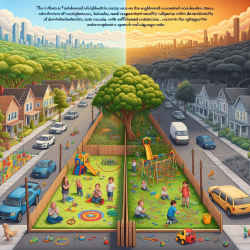Understanding the Role of Neighborhood Socioeconomic Status in ASD Development
As a speech-language pathologist dedicated to improving outcomes for children, understanding the factors that influence developmental vulnerability in children with Autism Spectrum Disorder (ASD) is crucial. A recent study titled Association between neighbourhood socioeconomic status and developmental vulnerability of kindergarten children with Autism Spectrum Disorder: A population level study sheds light on the significant role neighborhood socioeconomic status (SES) plays in the developmental health of children with ASD.
Key Findings from the Study
The study utilized data from a population-level database of child development in kindergarten across 10 provinces and territories in Canada. The research aimed to explore the association between neighborhood SES and developmental vulnerability in children with ASD, controlling for family SES. Key findings include:
- Higher neighborhood SES is generally associated with better developmental outcomes in children with ASD in several Canadian provinces.
- Inconsistencies were noted in Nova Scotia, where higher neighborhood SES correlated with increased vulnerability in social competence and communication skills.
- The study emphasizes the need to address neighborhood deprivation to support the development of children with ASD.
Implications for Practitioners
For practitioners, these findings highlight the importance of considering neighborhood factors when designing interventions for children with ASD. Here are some practical steps you can take:
- Advocate for Community Resources: Work with local governments and organizations to improve neighborhood resources, which can positively impact child development.
- Tailor Interventions: Customize interventions based on the specific needs and SES of the neighborhood, recognizing that a one-size-fits-all approach may not be effective.
- Collaborate with Families: Engage families in discussions about how neighborhood factors may affect their child's development and explore strategies to mitigate negative impacts.
Encouraging Further Research
This study opens the door for further research into the mechanisms through which neighborhood SES affects developmental outcomes in children with ASD. Future research could explore:
- The specific components of neighborhood SES that most significantly impact developmental vulnerability.
- Longitudinal studies to assess the long-term effects of neighborhood SES on developmental trajectories in children with ASD.
- Interventions at the neighborhood level that could mitigate the negative impacts of low SES on child development.
Conclusion
Understanding the influence of neighborhood SES on the developmental vulnerability of children with ASD is crucial for practitioners aiming to improve outcomes. By considering these factors and advocating for targeted interventions, we can better support the developmental health of children with ASD.
To read the original research paper, please follow this link: Association between neighbourhood socioeconomic status and developmental vulnerability of kindergarten children with Autism Spectrum Disorder: A population level study.










